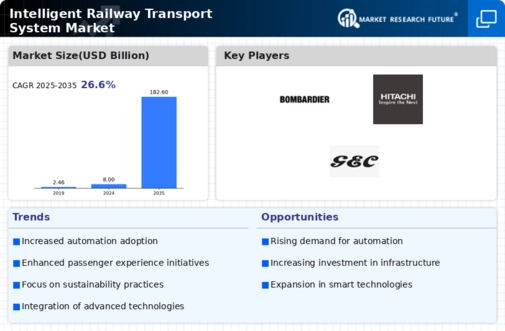Market Share
Intelligent Railway Transport System Market Share Analysis
In the competitive landscape of the Intelligent Railway Transport System (IRTS) market, companies deploy various market share positioning strategies to gain a competitive edge and secure a significant portion of the market. One prevalent strategy involves technological innovation and differentiation. Companies strive to develop and integrate cutting-edge technologies into their IRTS offerings, such as advanced sensors, artificial intelligence, and data analytics. By differentiating themselves through innovation, they aim to capture the attention of customers seeking state-of-the-art solutions that provide enhanced safety, efficiency, and reliability in railway transportation. Partnerships and mergers are important parts of how companies get market share in the IRTS area. Many companies make partnerships with other important players like train operators, tech suppliers and government groups. These teams help share knowledge, tools and access to markets. This allows businesses to make total solutions that work well together. Working together makes IRTS products better. It puts businesses in a good spot by using the same strengths and skills with others.
Growing and getting into the market is really important for positioning to get a bigger share of it. Businesses are always looking for chances to go into new places and markets, taking advantage of the increasing need for smart train solutions. Growing plans could involve making products fit for different areas, following local rules and getting a big spot in these places. By carefully growing their area, businesses can raise how much of the market they own and benefit from new chances in different places.
Strategies that put customers first aim to know and handle the special needs of railway companies and users. By making helpful choices that match what customers need, businesses can create strong friendships and trust. This way of focusing on the customer uses constant communication, ways to get feedback and helpful support for customers. Good customer experiences make the company's name better. This can affect what people buy, so it makes them more likely to get a bigger share of customers in the market.
Strategies for reducing costs are also used a lot in the IRTS market. Businesses try to give cheap choices that don't drop quality or work well. Good ways to make things, big companies and careful spending help keep prices down. This is good because it makes goods more interesting for money-sensitive people. This way of focusing on cost can be a big difference maker in markets where people care about price a lot. It helps companies get more share of the market by giving customers great value for their money.
Following rules and meeting industry standards is important for market share in the IRTS business. Following or doing better than safety and rule rules makes customers as well as watchers feel sure. Businesses that actively deal with rules and show they follow industry standards become known as trustworthy partners. This can be very helpful in markets where rules are watched closely. It lets companies get ahead of their competitors and become a bigger part of the market. Strategies that emphasize sustainability and environmental responsibility contribute to market share positioning in an era of increased awareness of climate change. Companies that incorporate energy-efficient technologies, reduce carbon footprints, and prioritize eco-friendly practices align with the growing demand for sustainable transportation solutions. Positioning themselves as environmentally responsible entities not only attracts environmentally conscious customers but also aligns with global trends and regulatory expectations.





Leave a Comment